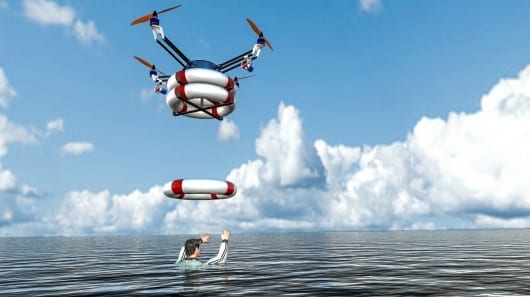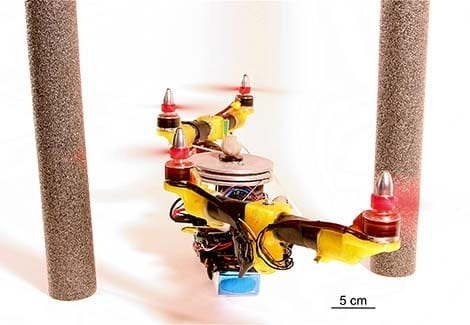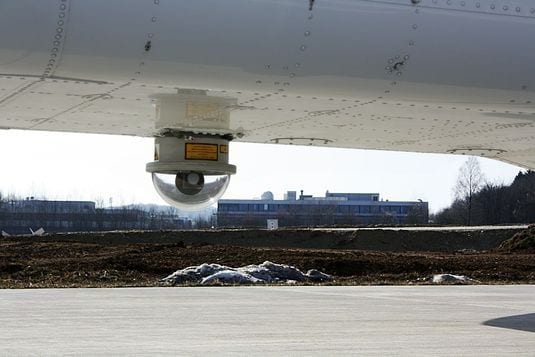
If current technology trends are any indication, it’s possible that human lifeguards could be replaced by robots in the future.
So far, we’ve seen a remote-controlled rescue buoy and a salamander-like bot that travels on both water and land, among many others. Rather than having to cut through rough water to get to folks in trouble like many search and rescue robot designs, an Iranian research center proposes a quadcopter called Pars that launches from a floating platform and drops life preservers precisely where they’re needed.
RTS Lab began developing Pars to address the high number of drowning victims in the Caspian Sea along the Iranian coastline. After creating a short-range rescue bot to help people near beaches, the team set to work on an improved model with much better capabilities.
The Pars design calls for a lightweight quadcopter equipped with a slew of sensors, including accelerometers, gyroscopes, GPS, a barometer, and an electronic compass. It’s most distinguishing feature, however, is a series of latches underneath that can hold and release life preservers one at a time. The most recent design can hold three tubes at once, but the developers claim future models could stock over 15 by using a chemical material that expands the padding after release.
An operator would be able to remotely control the robots manually or an onboard artificial intelligence could allow it to act autonomously in certain situations. RTS Lab says it has made a point of keeping the controls simple, so that a rescue worker could learn to operate them with just a few days of training.
The group also designed a charging station that would use solar energy to recharge several Pars units when they are docked. The designers claim the platform could be attached to the top of a rescue boat or offshore structure and could even be modified into a standalone floating station. In the event of system failure or low power, the aerial bot floats in water even without the life preservers, so it can easily be recovered later.
The Latest Bing News on:
Aerial robot
- Here are 4 ways to defend against unmanned ground vehicleson April 25, 2024 at 11:28 am
Global militaries are increasingly building, deploying, and operating unmanned ground vehicles, or UGVs. Mykhalio Fedorov, Ukraine’s Vice Prime Minister for Innovations, wrote on Twitter that, “I ...
- US military stages world’s first ever robot vs. pilot dogfight at 1,200 mphon April 24, 2024 at 12:13 pm
The US Air Force conducted the first successful dogfight between an AI-controlled experimental aircraft and a manned fighter jet. The AI-jet, an F-16 variant called the X-62A VISTA, engaged in ...
- Virtual sensors help aerial vehicles stay aloft when rotors failon April 24, 2024 at 10:35 am
No crystal ball is needed to envision a future that engineers have in mind, one in which air taxis and other flying vehicles ferry passengers between urban locations, avoiding the growing gridlock on ...
- Ukraine Military Situation Report | April 24on April 24, 2024 at 10:04 am
Below Hudson Senior Fellow Can Kasapoğlu offers a military situation report about the war in Ukraine. Executive Summary ...
- In Texas, can police fly a drone over your home? Here’s the state’s privacy law explainedon April 24, 2024 at 5:58 am
Texas Privacy Act allows the police to fly unmanned aerial vehicles, or drones, over your property if they have reasonable suspicion that you are committing a crime. You will not be met with guns ...
- Anzu Robotics Enters the Drone Market and Launches Two Enterprise Drone Platformson April 17, 2024 at 10:38 am
Anzu Robotics, LLC (“Anzu Robotics”) is proud to announce its entrance into the drone market with the launch of two groundbreaking platforms; the Raptor and Raptor T. Leveraging the latest ...
- Capture breathtaking aerial footage with this under $200 double drone bundleon April 8, 2024 at 6:00 am
Its optical flow sensor ensures easy achieving precise hovering and exact positioning, simplifying capturing stunning aerial shots with unmatched precision. Together, the two drones offer a ...
- CEC researchers receive funding for aerial vehicle and intelligent autonomy range for experimentationon March 31, 2024 at 5:00 pm
state-of-the-art robotics experimentation, testing, and competition venue. The proposed Aerial Vehicle and Intelligent Autonomy Range for Experimentation (AVIARE) will enable an aggressive and ...
- Russia’s First-Ever Robotic Ground Assault Ended Badly ... For The Robotson March 29, 2024 at 4:44 pm
The air might be the perfect medium for a drone. The sea, a close second. After all, avoiding obstacles is one of hardest tasks for the distant operator of some remote-controlled robot. There aren ...
- MSc Aerial Roboticson September 20, 2023 at 4:47 am
The MSc Aerial Robotics will provide you with the knowledge required to become an innovator in aerial robotic systems and tackle the latest challenges for Uncrewed Air Vehicles (UAVs) or drones, from ...
The Latest Google Headlines on:
Aerial robot
[google_news title=”” keyword=”aerial robot” num_posts=”10″ blurb_length=”0″ show_thumb=”left”] [/vc_column_text]The Latest Bing News on:
Aerial rescue robot
- The Evolution Of Military Drones: Harnessing The Power Of Artificial Intelligenceon April 28, 2024 at 2:30 am
In military defence applications, AI-powered drones play a pivotal role in operating in complex environments with minimal human intervention ...
- China unveils “Tiangong”: First fully electric humanoid robot capable of running at 6 km/hon April 27, 2024 at 5:10 am
China's Beijing Humanoid Robot Innovation Center unveils "Tiangong," a robot capable of human-like running at 6 km/h.
- Robots cannot outrun animals, but they’re evolving fasteron April 26, 2024 at 11:30 am
Despite these efforts, today's robots still cannot match the natural abilities of many animals in terms of endurance ...
- US tests bigger, meaner variant of Terminator-like robot drone tankon April 25, 2024 at 2:00 am
DARPA has reported the successful testing of its latest, giant 12-ton TEXTRON M5 RIPSAW-based RACER autonomous ground vehicle.
- Can you get a DJI drone that isn't made in China? Meet the Aznu Robotics Raptor...on April 23, 2024 at 3:53 am
So how will the drone avoid being Chinese? Well, according to drone industry followers DroneDJ, the Anzu Raptor is the result of a business partnership with DJI in which Anzu, a Texas-based (so ...
- Missile Defense Agency opts for Lockheed on $17 billion interceptor dealon April 19, 2024 at 10:42 am
In the race to update missiles to defend the homeland, Lockheed notches a win. Also, the Coast Guard makes a major rescue in the Pacific.
- National Guard will use Google's AI for faster disaster response and recoveryon April 17, 2024 at 11:53 am
The new AI tools will be able to evaluate aerial images of disasters in just ... the National Guard handles damage assessment, search and rescue, and logistics. But it's hampered by a slow and ...
- Boston Dynamics unveils an all-electric version of its Atlas roboton April 17, 2024 at 8:15 am
Atlas was originally envisioned as a search-and-rescue robot and Boston Dynamics claims the latest model is designed for real-world applications. It calls Atlas "the world’s most dynamic ...
- This hopping robot with flailing legs could explore asteroids in the futureon April 17, 2024 at 5:00 am
Menteebot is a human-sized robot that’s stuffed with AI bells and whistles. Users can command the bot to do their bidding via natural language prompts and it can learn new tasks. Nvidia CEO ...
- Navy Helicopters Have Morphed Into Drone Killers Right Before Our Eyeson April 2, 2024 at 7:00 am
565SA Panther naval helicopter attached to the French air defense frigate Alsace was patrolling near a civilian container ship when it was dispatched to intercept an approaching aerial drone.
The Latest Google Headlines on:
Aerial rescue robot
[google_news title=”” keyword=”aerial rescue robot” num_posts=”10″ blurb_length=”0″ show_thumb=”left”]










